Aziz Herawi (1952 - January 29, 2011 in Herat, Afghanistan) was a noted musician from Afghanistan. He specializes in the dutar and rubab, both plucked string instruments. Afghan musician Aziz Herawi was seven years of age the first time he heard the strings of the dutar being plucked. He talked one of the family servants, who hid it in a blanket, into buying the instrument for him from a shepherd. The boy would wait until his father was asleep, then sneak into the woods surrounding their home. Alone, in the dark, he practiced, teaching himself to play the long-necked 12-stringed dutar.
Herawi lived in northern California since 1985 and released several albums. His music is a blend of Persian and Hindustani instruments and styles and considered to be typical of Herat, Herawi's hometown, near the northeastern border with Iran. [1]
Aziz Herawi died January 29, 2011 in Herat Afghanistan while he visited family.
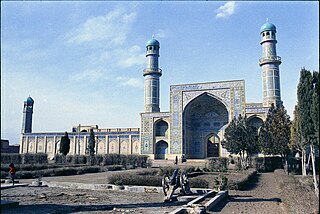
Herāt is an oasis city and the third-largest city in Afghanistan. In 2020, it had an estimated population of 574,276, and serves as the capital of Herat Province, situated south of the Paropamisus Mountains in the fertile valley of the Hari River in the western part of the country. An ancient civilization on the Silk Road between West, Central and South Asia, it serves as a regional hub in the country's west.

String instruments, stringed instruments, or chordophones are musical instruments that produce sound from vibrating strings when a performer plays or sounds the strings in some manner.

The sitar is a plucked stringed instrument, originating from the Indian subcontinent, used in Hindustani classical music. The instrument was invented in medieval India, flourished in the 18th century, and arrived at its present form in 19th-century India. Khusrau Khan, an 18th-century figure of the Mughal Empire has been identified by modern scholarship as the inventor of the sitar. According to most historians, he developed the sitar from the setar, an Iranian instrument of Abbasid or Safavid origin. Another view supported by a minority of scholars is that Khusrau Khan developed it from Veena.
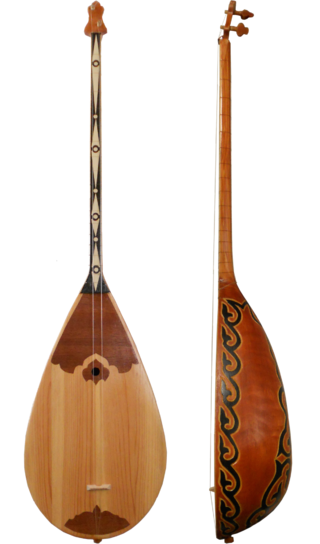
The Dombra, also known as Dombyra or Tambura is a long-necked musical string instrument used by the Kazakhs, Uzbeks, Turkmens, Hazaras, Bashkirs and Nogais in their traditional folk music. The Dombura shares certain characteristics with the komuz and dutar instruments, such as its long, thin neck and oblong body shape. It is a popular instrument mostly among Turkic and Iranic communities in Central Asian countries such as Kazakhstan, Uzbekistan, Tajikistan, Turkmenistan and Afghanistan.
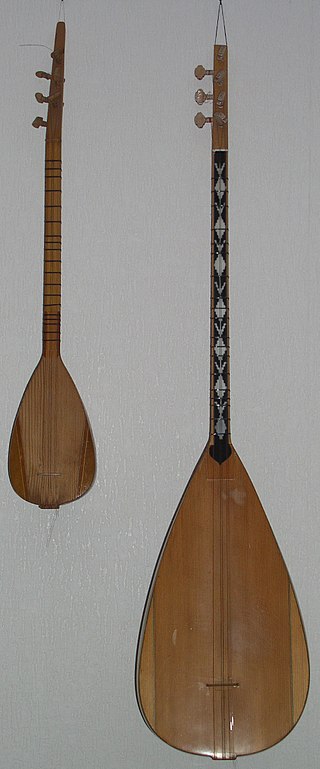
The bağlama or saz is a family of plucked string instruments, long-necked lutes used in Ottoman classical music, Turkish folk music, Turkish Arabesque music, Azerbaijani music, Bosnian music (Sevdalinka), Kurdish music, Armenian music. It is played in several regions in the world such as Europe, Asia, Black Sea, Caucasus regions and many countries including Syria, Iraq, Iran and Bosnia and Herzegovina.

The music of Afghanistan comprises many varieties of classical music, folk music, and modern popular music. Afghanistan has a rich musical heritage and features a mix of Persian melodies, Indian compositional principles, and sounds from ethnic groups such as the Pashtuns, Tajiks and Hazaras. Instruments used range from Indian tablas to long-necked lutes. Afghanistan's classical music is closely related to Hindustani classical music while sourcing much of its lyrics directly from classical Persian poetry such as Mawlana Balkhi (Rumi) and the Iranian tradition indigenous to central Asia. Lyrics throughout most of Afghanistan are typically in Dari (Persian) and Pashto. The multi-ethnic city of Kabul has long been the regional cultural capital, but outsiders have tended to focus on the city of Herat, which is home to traditions more closely related to Iranian music than in the rest of the country.

The komuz or qomuz is an ancient fretless string instrument used in Central Asian music, related to certain other Turkic string instruments, the Mongolian tovshuur, and the lute. The instrument can be found in Turkic ethnic groups, from China to Turkey. Forms of this instrument are used in China by the Naxi people and are called Huobusi, Hebisi , and Hunbusi.
The music of Central Asia is as vast and unique as the many cultures and peoples who inhabit the region. Principal instrument types are two- or three-stringed lutes, the necks either fretted or fretless; fiddles made of horsehair; flutes, mostly sige at both ends and either end-blown or side-blown; and jew harps, mostly metal. Percussion instruments include frame drums, tambourines, and kettledrums. Instrumental polyphony is achieved primarily by lutes and fiddles.

Ektara is a one-stringed musical instrument used in the traditional music of the Indian subcontinent, and used in modern-day music of Bangladesh, India, and Pakistan.

A setar is a stringed instrument, a type of lute used in Persian traditional music, played solo or accompanying voice. It is a member of the tanbur family of long-necked lutes with a range of more than two and a half octaves. Originally a three stringed instrument, a fourth string was added by Mushtaq Ali Shah by the mid 19th century. It is played with the index finger of the right hand.

Nadia Anjuman was a poet from Afghanistan.

The dotara is a two-stringed, plucked musical instrument from South Asia, with most contemporary models having four playing strings. Comparatively, the sarod is a slightly larger and more elaborate instrument, being built with an additional set of resonant sympathetic strings. However, the dotara is still quite resonant and projective of its own sound, due to its rounded shape and overall construction. It is commonly played in Bangladesh and the Indian states of Assam, West Bengal and Bihar. It was mentioned in a 14th-century Saptakanda Ramayana. Later, it was adopted by the ascetic cults of Bauls and Fakirs.
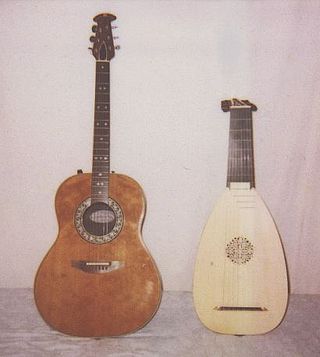
Plucked string instruments are a subcategory of string instruments that are played by plucking the strings. Plucking is a way of pulling and releasing the string in such a way as to give it an impulse that causes the string to vibrate. Plucking can be done with either a finger or a plectrum.

Rubab, Robab or Rabab is a lute-like musical instrument. The rubab, one of the national musical instruments of Afghanistan, is also commonly played in Pakistan and India by Pashtuns, Balochis, Sindhis, Kashmiris and Punjabis. The rubab has three variants, the Kabuli rebab of Afghanistan, the Rawap of Xinjiang, the Pamiri rubab of Tajikistan and the seni rebab of northern India. The instrument and its variants spread throughout West, Central, South and Southeast Asia. The Kabuli rebab from Afghanistan derives its name from the Arabic rebab and is played with a bow while in Central Asia and the Indian subcontinent, the instrument is plucked and is distinctly different in construction.

The çifteli is a plucked string instrument, with only two strings, played mainly by the Albanians of northern and central Albania, southern Montenegro and parts of North Macedonia and Kosovo.
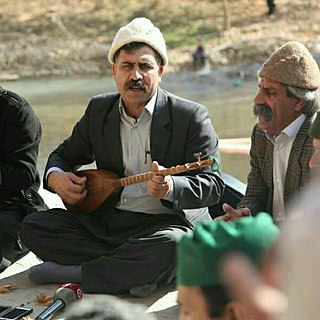
The term Tanbur can refer to various long-necked string instruments originating in Mesopotamia, Southern or Central Asia. According to the New Grove Dictionary of Music and Musicians, "terminology presents a complicated situation. Nowadays the term tanbur is applied to a variety of distinct and related long-necked lutes used in art and folk traditions. Similar or identical instruments are also known by other terms." These instruments are used in the traditional music of Iran, India, Kurdistan, Armenia, Afghanistan, Azerbaijan, Pakistan, Turkey, Tajikistan, Kazakhstan, and Uzbekistan.
The zerbaghali is a goblet-shaped hand drum that is played in the folk music of Afghanistan.

The dutar is a traditional Iranian long-necked two-stringed lute found in Iran and Central Asia. Its name comes from the Persian word for "two strings", دوتار do tār, although the Herati dutar of Afghanistan has fourteen strings. Dutar is very popular in Tajikistan and Khorasan province of Iran. When played, the strings are usually plucked by the Uyghurs of Western China and strummed and plucked by the Tajiks, Turkmen, Uzbeks. Related instruments include the Kazakh dombra. The Dutar is also an important instrument among the Kurds of Khorasan amongst whom Haj Ghorban Soleimani of Quchan was a noted virtuoso. In Kurdish one who plays the dutar is known as a bakci (bakhshi), while in Azeri the term is ashiq. Khorasan bakhshi music is recognized on the Representative List of the Intangible Cultural Heritage of Humanity.
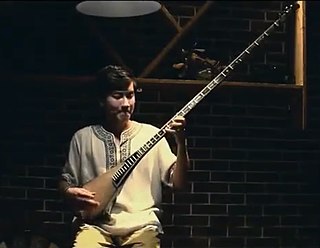
The tembor is a long-necked lute used in the music of Xinjiang, a diverse region of western China. Specifically, it is used by the Uyghur ethnic group.

Lutes are stringed musical instruments that include a body and "a neck which serves both as a handle and as a means of stretching the strings beyond the body".